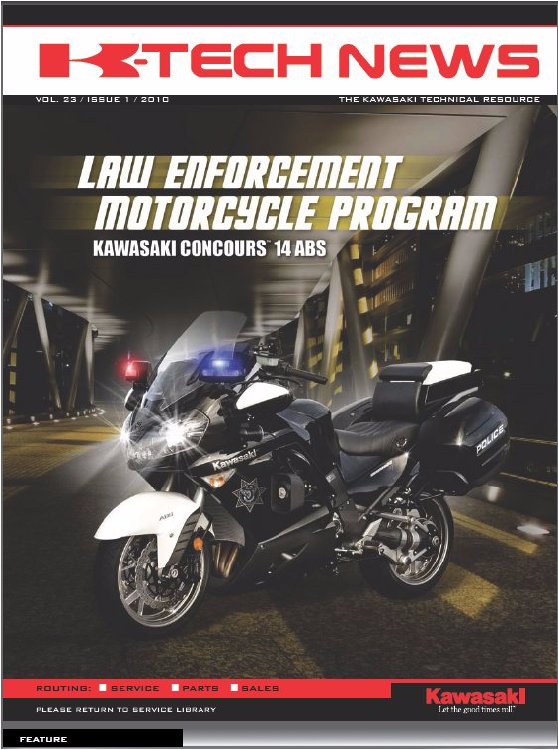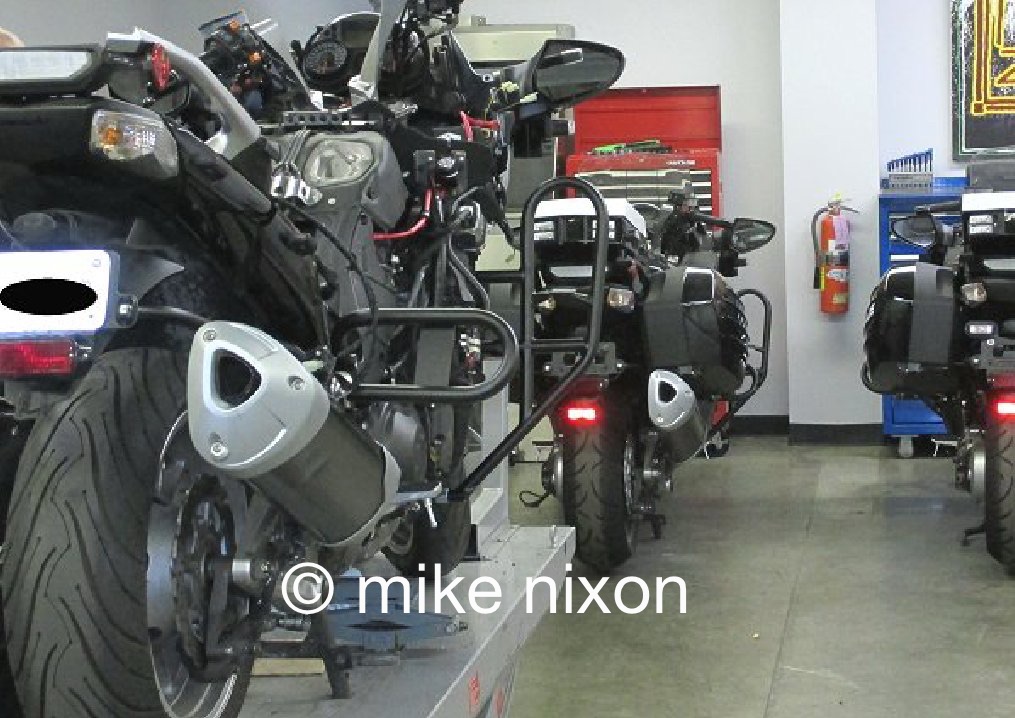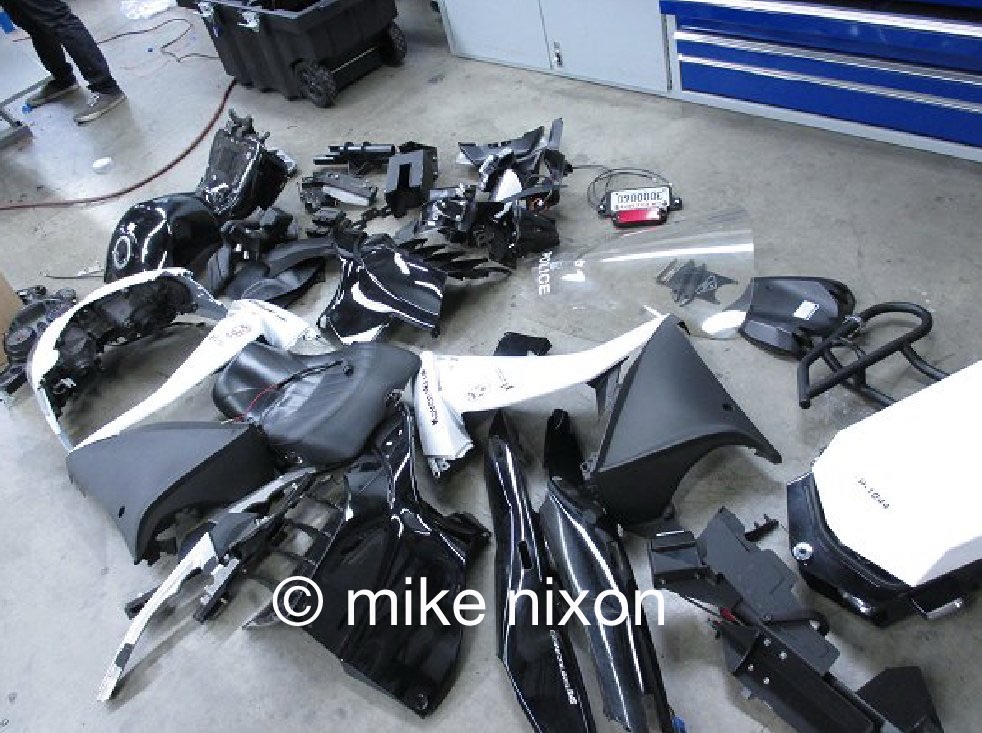  ® ®
|
|
|
The Kawasaki Police Bike Recall
|

|
|
Kawasaki corporate's then monthly newsletter to dealer mechanics celebrating the new police bike program. A very proud moment.
|
The ZG1400 Concours was an early release bike, one of only two Kawasakis unveiled in 2007 as 2008 year models. The aluminum-framed, reverse gear-equipped, KX450-engined KFX450R race-spec ATV was the other. Both were high-performing, cutting edge, superlatively ground-breaking models. With a powerplant that was essentially a detuned (less 45hp) ZX-14 engine, the new Connie put the sport back into sport touring, while the rest of the bike's creds and technology -- variable valve timing, articulated shaft drive, keyless entry, motorized windscreen, and available ABS -- more than lived up to the promise hinted at by its power. No wonder the C14 soon became the sought-after police model. Of course it didn't hurt that a lot of the officers who back in the day patrolled on the original KZ police bikes were by this time in decision-making positions. Also advantageous for law enforcement sales was that this buying segment actually challenged the civilian market for the new Concours, numbers-wise. European sales were also very vigorous.
Kawasaki has of course a rich history in the US police bike world beginning with the introduction of the original factory-produced KZ-based police bike in the 1970s. Hugely successful, the CHiPs machine virtually defined "police bike" everywhere that the Harley product was not completely entrenched, and happily, even many places where it was. However, after more than two dozen years of the same incrementally updated machine and amidst increasing competition from other brands, it was time for a change. The last Z1 copsickle was the 2005 model, and for a few years there was no new Kawasaki police bike available.
Almost concurrent with the Concours' 2007 release, third party vendors experienced with the conversion of BMWs and other motorcycles into police bikes for numerous law enforcement agencies were already busily outfitting the new machine. Police agencies all over the continent were dumping their BMWs (a major magazine reported that frequent repairs and poor factory support did in the Beemers) and Harleys en masse in favor of the new machine, and specialty shops all over were hard at work meeting that need, turning out police-spec mounts. Kawasaki corporate soon took notice and approached the most prominant police bike builder with a plan designed to drive Concours sales, and a deal was struck that would put the big K in the police bike business once again.

|
|
Southern California area police department Concours waiting their turn to get rebuilt at Kawasaki's then headquarters in Irvine, California.
|
Sort of. The plan had Kawasaki expanding its already-existing fleet department, until now concerned mainly with selling Mule utility vehicles in bulk to vineyards, ranches, oil refineries and the like, to include the then-2009 model Concours, available in lot quantities to Kawasaki dealers in this fledgling program. The dealers would in turn sell the machines in numbers to law local enforcement departments, who would individually arrange fitting out by Kawasaki's now-official vendor. The kicker was Kawasaki's unprecedented and bold agreement to vet this vendor's many police-spec modifications, to the point of full factory warranty, in an attempt to give the converted bikes the desired factory stamp. All seemed well. But unfortunately not for long.
Concours police bikes started blowing main fuses. And blowing them. Police departments were sidelining bikes. The California Highway Patrol rang Kawasaki's phones off the walls. Kawie Corporate issued a bulletin to assure all that they were aware and working on a solution. A second bulletin followed. And a third. Very quickly, problems with the custom-modified Connies ballooned into a massive safety recall and a commitment on Kawasaki's part ultimately to repair over 350 bikes, a campaign that today stands as the largest most expensive, most comprehensive recall in Kawasaki's history and doubtless one that without significant assistance from Japan would surely have bankrupted the marque's modest US headquarters. Corporate embargoed further fleet sales in an attempt to stop new police bike builds. The official vendor fought back, suing Kawasaki, and eventually reorganized under a new name.
Fantastically, more than $8,000 in repair costs was allotted to each unit. Each bike was stripped to engine, wheels and frame, then put back together. In addition to the complete reengineering of the original vendor's dual-battery electrical system including a newly designed custom wiring harness and revised modifications to the front cowl, the entire subframe/radio box, handlebars and steering, saddlebag guards, and much more were redesigned in a collaborate effort between Kawasaki's R&D dept. in California and the factory in Akashi, Japan. Over 200 unique new part numbers were added to Kawasaki's system, the work scripted in detail in specially created factory parts lists and procedure manuals originating in my department. Because law enforcement agencies universally refused to take the bikes to dealers (due in part no doubt to their previous somewhat memorable experience with BMW), teams of superbly gifted, carefully selected and highly trained technicians were sent across the country laden with five foot long valises stuffed with special tools and supplies to spend on average two days on each machine, often in rented buildings having blacked-out windows to keep the activity secret. In short, the most major of major undertakings. In the end, Kawasaki was indeed back in the police bike business, but painfully not even remotely in the way they had planned.

|
|
All of the bodywork off of a unit. There is a lot of it on a Concours. Note the fuel tank at the left and the radio box to the right. The windscreen is in the middle.
|
The good ending in the story did eventually come, late in 2016. Repaired bikes stayed repaired. Law enforcement's remarkable loyalty was preserved -- and through the company's diligence, enchanced -- and Concours orders from law enforcement resumed at their former encourging levels. Kawasaki's massive three-year police bike rebuild project was completed and became history, allowing the big K's corporate office to go on to other things. As the end neared, there was talk at the corporate office of the rebuild project's cost being at least partly recovered by sales of conversion kits. Easy enough to do: parts lists and new vendors all set up (took several weeks to find quality Bosch type relays, for example), procedures and manuals written and field tested, everything in place. It would as an additional important benefit also largely affect the third part builders' quality too. A winning combination, me thinks. However, it never got off the ground while I was still there. For one thing, Japan strongly discouraged the idea and reportedly favored a plan that harkened back to the 80s with a preconfigured Japan-built police bike crafted from the saddlebag-equipped Ninja 1000 sport tourer. We'll just have to wait and see.
One thing's for certain. Though Kawasaki had an obvious reponsibility and therefore couldn't ultimately escape the long arm of the law personifiied by the NHTSA, it is nonetheless remarkable the extent and the thoroughness with which the company acted. They could have put the burden on their dealers (as Honda and Yamaha did in similar circumstances), and they didn't. They could have "jerry-rigged" the repair, and happily, they didn't do that either, choosing instead to basically build the bikes the way they should have been in the first place. I believe the company's law enforcement customers, its dealers, and even to a small extent the public have noticed and this demonstration of goodwill and commitment will in the end hugely benefit Kawasaki. Let the Good Times Roll!
Suggested further reading on this site:
Concours intro media Q & A
Early Honda V4 history
The Kawasaki Concours' KIPASS system
Introducing the new Kawasaki Concours
The Kawasaki Concours ten years later
Factory KDS training book
|
|